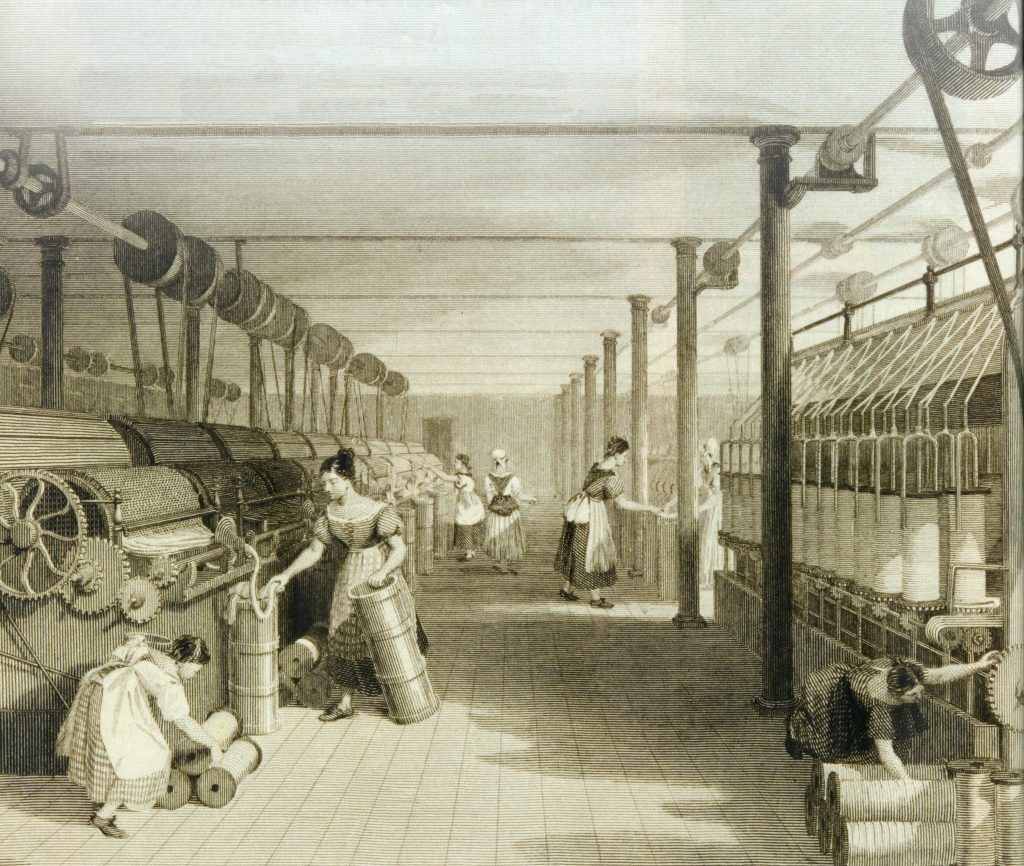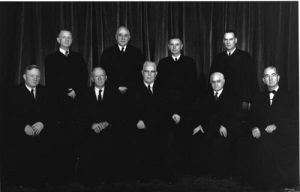Children today spend five days a week going to school for eight hours. During the first half of the nineteenth century in Britain, this was not the case. Instead, children even as young as five or six would toil all day long in factories or in mines. They had no breaks, no time off, and no schooling. Their work often led to horrible accidents, children being injured for life, and children left without an education.
Children laboring, of course, did not start with the British Industrial Revolution. It had been a normal part of life in Europe since the middle ages, when children helped their parents on farms and with household work. The people’s perception of this work, however, changed during the Industrial Revolution, since that is when people began to see this new kind of labor, factory labor, as an injustice and even criminal.1
The Industrial Revolution began in Britain during the 1780’s and rapidly changed the work process and the social relations of work. Prior to the Industrial Revolution, most people worked directly in the production of food, usually as farmers on their own farms. When textile factories began forming in the new factory cities, instead of working on their farms and making what their family needed, people left their farms and moved into the factory cities to make a living. Factory conditions of work, however, were far different from the work rhythms of farm life. In fact, they were brutal in comparison. Factory workers would typically put in between 12 and 16 hour days, working for meager wages. The machines they attended were dangerous, and the workers were often on their feet throughout the day, with perhaps a half-hour break for meals. Among these workers were children, many of whom were as young as five or six years old. Children were valued as workers for their small stature and ability to climb into small places and do things that adults often could not do. This often resulted in mutilation and the loss of appendages for many of these children.2
Children were also valued as workers by the factory owners because of the low wages that they were paid. Men were paid the most in factories, followed by women and then children. These wages, however small, were needed by the families of these children simply to survive. The parents often sent their children out to work to help pay for rent, food, and otherwise help make ends meet.3
One reason that the British public became outraged by child labor practices was the fact that children in factories were not receiving an education. Horace Mann, an American educational reformer, stated:
No greater calamity can befall us as a nation than that our children should grow up without knowledge and cultivation. If we do not prepare them to become good citizens, develop their capacities, enrich their minds with knowledge, imbue their hearts with a love of truth and all things holy, then our republic must go down to destruction as others have gone before it.4
This represents the thoughts of the British at the time, which was being echoed in the United States during its own industrial revolution. People wanted to ensure the future of their nation, which starts with the young. They believed that children should attend school for at least a while.5 This led to several laws being passed to raise the legal age of work.
In 1833, the British Parliament passed the Regulation of Child Labor law to help improve the working conditions for children in factories. The Law limited the age of workers, saying that they had to be older than nine with an age certificate to prove it, and that children 9-13 could not work for more than nine hours a day. Additionally, children 13-18 were not permitted to work longer than twelve hours a day. Along with these work-hour restrictions, the law also made school attendance a two-hour requirement, and said that children could not work at night. Fines for breaking these rules were small, however, so they were frequently violated, often with impunity.6

Many other pieces of legislation were also passed to place limits on the gender, hours, and ages of workers. The Mining Act of 1842 prevented women and girls from working in mines, and the Ten Hours Bill of 1847 set ten as the maximum number of daily working hours for women and children. This act was hated by factory owners because they believed it would hurt the textile industry’s competitiveness worldwide. After these bills, others followed to ensure their effectiveness, and to ensure that they would be properly implemented.7
By 1900, the minimum working age had been raised to twelve years of age and child labor had decreased drastically in Great Britain. However, the introduction of legislation against child labor provoked its share of protests as well. Because of these protests, Parliament established commissions to collect evidence of abusive practices. These were called the Blue Books or Sadler Reports. They interviewed children, parents, factory workers, owners, and even doctors on the condition of children in textile factories. Unsurprisingly, the reports uncovered a range of serious abuses by factory owners and overseers. Unfortunately, most critics just said that the claims were exaggerated in order to continue their money making practices.8
The legislation surrounding the British Industrial Revolution had become very effective by 1900, and child labor and its accompanying abuses had decreased dramatically. By 1900, most children were attending school instead of working in factories. The laws passed finally added up to changing British child labor to being closer to what we see today, a mostly child-free labor system, with children going to school and adults having regulated working hours.
- World History Encyclopedia, 2011, s.v. “Child Labor and Child Labor Laws in Early Industrial Great Britain.” ↵
- James D. Schmidt, “Broken Promises: Child Labor and Industrial Violence,” Insights on Law & Society, no. 3 (Spring 2010): 14–17. ↵
- Robert Whaples, “Hard at Work in Factories and Mines: The Economics of Child Labor during the British Industrial Revolution,” Business History Review, no. 2 (2001): 429. ↵
- Friends’ Intelligencer vol. 28 no. 1 (1871): 336. ↵
- James D. Schmidt, “Broken Promises: Child Labor and Industrial Violence,” Insights on Law & Society, no. 3 (Spring 2010), 14–17. ↵
- Great Britain, “Factories Regulation Act” (1833). ↵
- Steven Toms and Alice Shepherd, “Creative Accounting in the British Industrial Revolution: Cotton Manufacturers and the ‘Ten Hours’ Movement,” MPRA Paper, No. 51478 (2013), 6-8. ↵
- World History Encyclopedia, 2011, s.v. “Child Labor and Child Labor Laws in Early Industrial Great Britain.” ↵



141 comments
Fumei P.
Child labor laws, something we take for granted nowadays. Not long ago it was normal for six year olds to work in a factory all day long. Today we have workers compensation if someone gets injured on the job they get medical coverage and wages to makeup for lost hours until they recover. I’m glad that the government came down and make it mandatory for children to go to school. I used to do odds and ends around the house as a child, but I could never imagine working in a coal mine or in a factory all day long. Life is good these days.
Andrew Dominguez
Its interesting to think kids were barely five years old, and being allowed to operate dangerous machines. When today kids today don’t know how to work the same machinery. I think its good child labor was banned, but not because of the dangerous working conditions. Kids that would be educated would do more for the country, than those who work. BY having education the country could advance.
Michael Thomas
I found this article interesting because of how the women and children were treated in the mills and factories during the Industrial Revolution. Around the time of the Industrial Revolution, families needed money to sustain themselves. Women and children worked in the mills and factories, but were paid less than the men. In the end, regulations were put in place to put an end to child labor.
Robert Rodriguez
Its sad to think that these children were basically forced to work in order to help support their families at just the age of 6, at the age of 6 I was in a class room without a care in the world. Having children work benefitted no one but the business owners! While the economy was boosted by child labor at the cost of children who got fingers cut off and received other work related injuries, by no means should that have even been socially acceptable. I am glad that we have come a long way and got rid of child labor and instead began educating them.
Hector Garcia
The Industrial Revolution was a very important time in history where inventions or new methods were created, such as the production line and cotton gin. But we sometimes fail to the see the negative repercussions the Industrial Revolution had. It is horrible to read of children who lost their appendages and how they were given a lower salary than everybody else. At the end of this article, I was glad to see that more children were going to schools rather than working in factories.
Samuel Stallcup
Child labor has always been a very interesting argument, for it seems there are a lot of benefits and possible gains from child labor. However, none of these benefits are for the children, they are all for the business owner. This article does a good job at showing why child labor was a big issue, and how it can still be looked at in sweatshops in Asia. Great article.
Max Lerma
From an economic perspective, the Industrial Revolution is always viewed as a time of massive growth for the world and overall beneficial. It is easy to forget the atrocities that occurred throughout this time period. While nations may have benefited greatly and a new more efficient economy ushered, many thousands suffered. This article reminds of us of this and the importance of the labor laws that came about to protect children who suffered most in these factories.
Julian Aguero
It’s astonishing to see how far people will go to save a dollar. The only thing that can stop these owners from exploiting the less fortunate is to make it illegal. Of course todays society does not function the same as the past therefore stigmas are not the same. However, it was clear that children were treated unfairly in the workplace. I’m glad that the government realized that education at a young age was important for the future of society.
Saira Castellanos
Well, if these kids didn’t work they would starve. These were different times where a superfluous amount of people were starving. People now are still starving every day, but the difference is that we are really trying to help those who don’t have anything to eat, and even then there are still so many people that don’t have anything to eat, so they send their kids off to work instead of getting an education. The good thing is that times have changed and we dont see this as often as it was back then.
Benjamin Arreguin
This article hit home in Mexico when I would see children who could barely speak who are bagging groceries in stores to support their family. Children who grow up in poverty realize how hard it is to see their families suffer, so whether they chose to be there or not, they had to work. People today have realized how bad it is for children to not go to school, and work instead, and how detrimental this is for their health and well-being as a person in general. Working at that young of an age is abuse, and many people are now standing against people who mistreat children for labor.